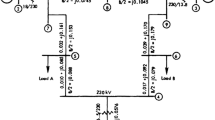Abstract
This paper presents a modified TLBO (teaching–learning-based optimization) approach for the local linear radial basis function neural network (LLRBFNN) model to classify multiple power signal disturbances. Cumulative sum average filter has been designed for localization and feature extraction of multiple power signal disturbances. The extracted features are fed as inputs to the modified TLBO-based LLRBFNN for classification. The performance of the proposed modified TLBO-based LLRBFNN model is compared with the conventional model in terms of convergence speed and classification accuracy. Also, an extreme learning machine (ELM) approach is used to optimize the performance of the proposed LLRBFNN and is compared with the TLBO method in classifying the multiple power signal disturbances. The classification results reveal that although the TLBO approach produces slightly better accuracy in comparison with the ELM approach, the latter is much faster in implementation, thus making it suitable for processing large quantum of power signal disturbance data.









Similar content being viewed by others
References
Shaw SR, Laughman CR, Leeb SB, Lepard RF (2000) A power quality prediction system. IEEE Trans Ind Electron 47(3):511–517
Zang H, Liu P, Malik OP (2003) Detection and classification of power quality disturbances in noisy conditions. IEE Proc Gener Transm Distrib 150(5):567–572
Gaouda AM, Salama MMA, Kanoun SH, Chikhani AY (2002) Pattern recognition applications for power system disturbance classification. IEEE Trans Power Deliv 17(3):677–682
Bollen MHJ, Gu IYH, Axelberg PGV, Styvaktakis E (2007) Classification of underlying causes of power quality disturbances: deterministic versus statistical methods. EURASIP J Adv Signal Process 2007(19):148
Daubechies Ingrid (1990) The wavelet transform, time–frequency localization and signal analysis. IEEE Trans Inf Theory 36(5):961–1005
Yang HT, Liao CC (2001) A de-noising scheme for enhancing wavelet-based power quality monitoring systems. IEEE Trans Power Deliv 16:353–360
Chung J, Powers EJ, Lamoree J, Bhatt SC (2002) Power disturbance classifier using a rule based and wavelet-packet based Hidden Markov model. IEEE Trans Power Deliv 17:233–241
Stockwell RG, Mansinha L, Lowe RP (1996) Localization of the complex spectrum: the S transform. IEEE Trans Signal Process 44(4):998–1001
Faisal MF, Mohamed A (2009) Identification of multiple power quality disturbances using S-transform and rule based classification technique. J Appl Sci 9(15):2688–2700
Nguyen T, Liao Y (2009) Power quality disturbance classification utilizing S-transform and binary feature matrix method. Electr Power Syst Res 79(4):569–575
Looney CG (2002) Radial basis functional link nets and fuzzy reasoning. Elsevier Sci Neurocomput 48(4):489–509
Albrecht S, Busch J et al (2000) Generalized radial basis function networks for classification and novelty detection: self organization of optimal Bayesian decision. Neural Netw 13:1075–1093
Jayasree T, Devaraj D, Sukanesh R (2010) Power quality disturbance classification using hilbert transform and RBF neural networks. Neurocomputing 73(7–9):1451–1456
Santoso S, Powers EJ, Grady WM, Parsons AC (2000) Power quality disturbance waveform recognition using wavelet-based neural classifier. I. Theoretical foundation. IEEE Trans Power Deliv 15:222–228
Wang T et al (2000) A wavelet neural network for the approximation of nonlinear multivariable function. Trans Inst Electr Eng C 102-C:185–193
Chen Y, Yang B, Dong J (2006) Time series prediction using a local linear wavelet neural network. Elsevier Sci Neurocomput 69:449–465
Nekoukar V, Beheshti MTH (2010) A Local linear radial basis function neural network for financial time series forecasting. Springer Appl Intell 33:352–356
Rao RV, Savsani VJ, Vakharia DP (2011) Teaching–learning-based optimization: a novel method for constrained mechanical design optimization problems. Elsevier Sci Comput Aided Des 43:303–315
Rao RV, Savsani VJ, Vakharia DP (2012) Teaching–learning-based optimization: an optimization method for continuous non-linear large scale problems. Elsevier Sci Inf Sci 183:1–15
Tuo S, Yong L, Zhou T (2013) An improved harmony search based on teaching-learning strategy for unconstrained optimization problems. Hindawi Math Probl Eng 2013:1–29
Rao RV, Patel V (2012) An elitist teaching-learning-based optimization algorithm for solving complex constrained optimization problems. Int J Ind Eng Comput 3:535–560
Rao RV, Patel V (2013) Multi-objective optimization of heat exchangers using a modified teaching-learning based optimization algorithm. Appl Math Model 37(3):1147–1162
Rao RV, Patel V (2013) Multi-objective optimization of two stage thermoelectric cooler using a modified teaching-learning based optimization algorithm. Eng Appl Artif Intell 26(1):430–445
Rao RV, Savsani VJ, Balic J (2012) Teaching-learning-based optimization algorithm for unconstrained and constrained real parameter optimization problems. Eng Optim 44(12):1447–1462
Huang G-B, Zhu Q-Y, Siew C-K (2006) Extreme learning machine: theory and applications. Neurocomputing 70(1–3):489–501
Huang G-B, Chen L, Siew C-K (2006) Universal approximation using incremental constructive feedforward networks with random hidden nodes. IEEE Trans Neural Netw 17(4):879–892
Huang G-B, Zhou H, Ding X, Zhang R (2012) Extreme learning machine for regression and multiclass classification. IEEE Trans Syst Man Cybern Part B 42(2):513–529
Han F, Yao H-F, Ling Q-H (2013) An improved evolutionary extreme learning machine based on particle swarm optimization. Neurocomputing 116:87–93
Huang GB, Wang DH, Lan Y (2011) Extreme learning machine-a survey. Int J Mach Learn Cybernet 2:107–122
Mishra S, Panda G, Biswal B (2011) Use of multiple change detection in pattern recognition using relevant vector machine and moving sum average filter. IEEE international conference on energy automation and signal, 28th–30th, ICEAS
Pradhan AK, Routray A, Mohanty SR (2006) A moving sum approach for fault detection of power system. Electric Power Compon Syst 34:385–399
Nayak PK, Pradhan AK (2009) Transmission line fault classification using moving sum approach. National conference on advances in computational intelligence applications in power, control, signal processing and telecommunication, NCACI, pp 1–4
Author information
Authors and Affiliations
Corresponding author
Rights and permissions
About this article
Cite this article
Nayak, P.K., Mishra, S., Dash, P.K. et al. Comparison of modified teaching–learning-based optimization and extreme learning machine for classification of multiple power signal disturbances. Neural Comput & Applic 27, 2107–2122 (2016). https://doi.org/10.1007/s00521-015-2010-0
Received:
Accepted:
Published:
Issue Date:
DOI: https://doi.org/10.1007/s00521-015-2010-0




